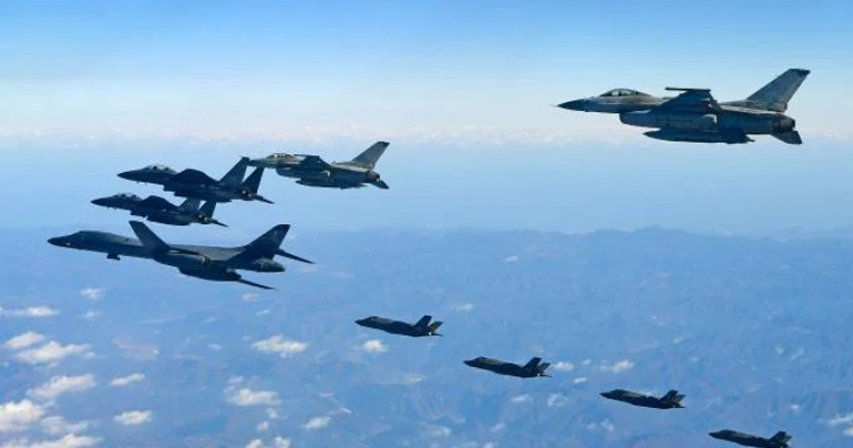US deploys bombers in show of force to China
- 4 years ago

America’s strategic bomber squadrons have been engaged in a co-ordinated show of force over the Indo-Pacific region and Europe to demonstrate that the US is ready to confront any aggression, even amid the coronavirus crisis.
All three types of the US air force’s long-range bombers - the B-2 Spirit stealth bomber, the B-52H Stratofortress and the B-1B Lancer - have recently been flying missions thousands of miles from their home bases. The B-2 and B-52H are designed to carry nuclear bombs and the B-1B has cruise missiles with conventional warheads.
The muscle-flexing is intended to send a signal to China, which has been taking advantage of the pandemic to boost its power in the Indo-Pacific region, with reports that some in Beijing are even clamouring for an invasion of Taiwan.
However, America remains committed and ready to fulfil its global missions, according to US Strategic Command. “This dynamic employment of long-range bombers and supporting aircraft showcased the United States’s ability to conduct synchronised strategic deterrence anywhere in the world with a ready, lethal force,” it said.
The US joint chiefs of staff, headed by General Mark Milley, are believed to have underlined this message when they joined President Trump for a special national security meeting on Saturday at the White House.
One key figure missing was Admiral Michael Gilday, chief of naval operations, who is self-isolating after having had contact with a Covid-19-positive family member. He tested negative but is in quarantine for a week.

A Northrop B-2 Spirit stealth bomber.
Emboldened by America’s apparent distraction, China has reasserted its claims over territories in the South and East China Seas by dispatching survey and coastguard ships, leading to confrontations with vessels from Vietnam, Malaysia and Japan. It also claims to have “expelled” US warships from waters around the Paracel Islands, which it claims as its own.
Last week two Chinese ships scared off a Japanese fishing boat in the waters around the Senkaku islands before the Japanese coastguard arrived and ordered the Chinese vessels to leave.
On Monday Beijing declared it had an “inherent right” to patrol the waters near disputed islands in the East China Sea.
A growing number of social media users in China are urging Beijing to exploit America’s preoccupation with the pandemic to invade Taiwan. At the same time, an influential state media boss in China has called for an expansion of the country’s nuclear arsenal, increasing it to 1000 warheads from its stockpile of about 300.
“You don’t ask for peaceful co-existence between countries, you forge it with strategic tools, especially when we are faced with the reality that we are interacting with difficulty with a United States that is becoming increasingly irrational,” wrote Hu Xijin, editor-in-chief of the Global Times, a Communist Party newspaper.

Munitions on display show the full capabilities of the B-52 Stratofortress. Picture: Tech. Sgt. Robert J. Horstman
The US is boosting its air power around the world after the navy faced weeks of bad headlines following the debacle involving the USS Theodore Roosevelt aircraft carrier. The ship has been docked in Guam since March 27 after more than a thousand crew members tested positive for coronavirus following a port visit in Vietnam. Several other US aircraft carriers are out of action or far from the Pacific.
Captain Brett Crozier, commanding officer of USS Theodore Roosevelt, was fired after his controversial appeal for help was leaked. However, Thomas Modly, acting navy secretary in Washington, was himself forced out soon afterwards after admitting that he was wrong to criticise the captain in front of the crew.
While the navy faces challenges, US Strategic Command, which is responsible for America’s nuclear deterrent triad - based on land, carried by submarines or launched from the air - has been emphasising the readiness of all three components. It disclosed that two bat-winged B-2 stealth bombers from Whiteman air force base in Missouri, two B-52Hs from Minot in North Dakota and two B-52Hs from Barksdale in Louisiana have been flying missions to the Indo-Pacific and Europe.
In addition, four B-1Bs have been deployed to Guam from Dyess air force base in Texas for operations in the region including over the South China Sea. A B-1B Lancer flew to Europe from its Ellsworth base in South Dakota.
The US announced last month that it was ending its continuous bomber presence at Andersen air force base in Guam after 15 years. However, the arrival of four Lancers for an unspecified period of deployment suggests a sudden change of heart.

President Trump is sending a message to China. Picture: AP
ANALYSIS
A superpower war involving China and the US has become that much easier to imagine this year, Richard Lloyd Parry writes.
The pandemic, far from bringing the world together in solidarity against a common enemy, is widening fissures into cracks, and cracks into crevasses.
Having reached a cautious truce in last year’s trade war, President Trump has made China’s culpability for the outbreak a central part of his re-election strategy. The status of Taiwan has again come to the fore.
China’s tactics may have become bolder but the strategy remains the same: superpower dominance achieved through an inexorable growth of economic, military and political strength; a strength that is still far from being fully realised.
President Xi and his strategists in the Communist Party believe that American decline, and Chinese resurgence, are matters of long-term historical inevitability, not short-term opportunism.
The spectacle of Mr Trump’s erratic presidency gives them more conviction than ever. However, they understand how much they have to lose by leaping for Taiwan too early, or by provoking outright confrontation with Japan when the balance of military power is not yet decisively in their favour.

This aerial photo shows a Chinese navy formation, including the aircraft carrier Liaoning, centre, during military drills in the South China Sea. Picture: AFP
Comments